How Will the Cloud Shape the Future of the Workforce?
August 01, 2014

By Michelle Nicolson
TMCnet Contributing Writer
As cloud technology continues to expand in business operations, companies may want to look ahead to see what’s next for workforce management solutions. Adapting to the changes ahead may be a make-or-break moment for many businesses, according to IHS (News - Alert), a global consulting and information company.
One of the biggest changes already on the scene is the adoption of software as a service (SaaS), which was made possible by the emergence of cloud-based computing. IHS estimates the global SaaS (News  - Alert) market will rise to $983.9 million in 2018, up from $539.0 million last year. Indeed, many businesses have already discovered the advantages of SaaS, which include lower upfront costs and automated software updates.
- Alert) market will rise to $983.9 million in 2018, up from $539.0 million last year. Indeed, many businesses have already discovered the advantages of SaaS, which include lower upfront costs and automated software updates.
“The adoption of SaaS will be driven by the strategic advantages offered to using cloud-based software,” said Samuel Grinter, analyst for enterprise resource planning at IHS. “The cloud enables customers to centralize management of workforce solutions over several sites, to outsource the information technology infrastructure required to host the software, and to pay for the solution as an operational expense rather than as a capital investment.”
SaaS is a disruptive technology, however, and vendors must adjust their customer service and marketing plans accordingly. Subscription-based software, for example, makes it easier to both upgrade licensing as needed, but also downgrade or cancel licenses altogether. As a result, software providers must increase their focus on quality customer service and competitive pricing.
 However, IHS remains bullish on the potential for SaaS to provide long-term growth for software developers who embrace the new paradigm.
However, IHS remains bullish on the potential for SaaS to provide long-term growth for software developers who embrace the new paradigm.
“As adoption of SaaS-based workforce management solutions increases, it is expected ultimately to lead to stable market growth,” Grinter said. “Stabilization will come from the regular monthly and annual revenues generated by SaaS relative to the more fluctuating revenue stream of perpetual license software. Furthermore, as the life-time cost of SaaS is more expensive than that of perpetual license software, the workforce management solution software market will ultimately grow.”
The cloud is also affecting the way businesses install hardware, as the ability to access to data via mobile devices is reducing the need for fixed hardware terminals. While that’s good news for mobile device manufacturers, other hardware vendors are likely to feel the pinch.
“As the prevalence of mobile and computer employee self-service increases, fewer hardware terminals are being installed per project, as employees can increasingly manage their data and clock in and out via their smart phone, computer or other device, such as a point of sale (POS) terminal,” Grinter said. “This effect is compounded by customers who are looking to reduce the total installation cost of workforce management solutions; this can, of course, be achieved by installing fewer terminals, which lowers the equipment, installation and maintenance costs.”
These findings from IHS are available in the white paper: Five Global Trends Shaping the Future of Workforce-Management Solutions.
Edited by Adam Brandt
|
Article comments powered by
|
 Internet Telephony Magazine
Click here to read latest issue
Internet Telephony Magazine
Click here to read latest issue CUSTOMER
CUSTOMER  Cloud Computing Magazine
Click here to read latest issue
Cloud Computing Magazine
Click here to read latest issue IoT EVOLUTION MAGAZINE
IoT EVOLUTION MAGAZINE




